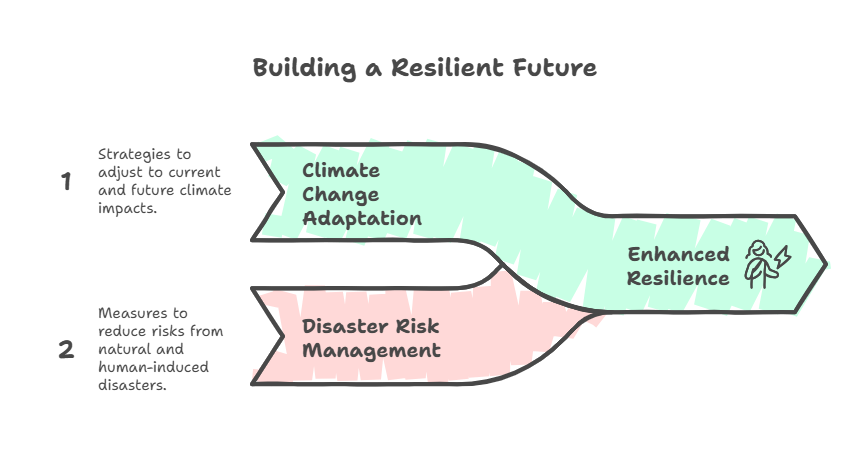-
Q. “With the increasing frequency and intensity of extreme weather events, India must urgently integrate climate change adaptation into its disaster risk management framework. Discuss in the context of recent events and policy responses.” (250 words)
09 Jul, 2025 GS Paper 3 Disaster ManagementApproach:
- Introduced the answer by briefing about India’s vulnerability to climate induced disasters.
- Highlight the Urgency of Integration of Climate Adaptation into DRM
- Delve into Recent Policy Responses and Gaps
- Suggest Measures for Integrating Climate Change Adaptation into its Disaster Risk Management Framework
- Conclude suitably.
Introduction
India, one of the most disaster-prone countries globally, faces over 300 extreme weather events annually (IMD, 2023), driven by climate change. The increasing intensity of cyclones, floods, droughts, and heatwaves is stretching India's disaster management system.
- In this context, integrating climate change adaptation (CCA) into disaster risk management (DRM) is no longer optional but a strategic imperative for resilience and sustainable development.
Urgency of Integration of Climate Adaptation into DRM:
- Climate-Induced Escalation of Disasters: Cyclone Mocha (2023) and record rainfall in Himachal Pradesh (2023) caused massive human and economic losses.
- India faced extreme weather on 314 out of 365 days in 2023 (CSE Report), indicating climate risks are systemic and not episodic.
- Urban Vulnerabilities: Chennai floods (2021) and Bengaluru floods (2022) exposed poor planning, encroachment on wetlands, and outdated drainage.
- Himalayan Fragility: Events like Kedarnath floods (2013) and Chamoli disaster (2021) and recent Joshimath Land Subsidence illustrate glacier retreat and landslide risks due to warming and development.
- Droughts and Water Stress: Erratic monsoons and heatwaves have increased agricultural distress; 40% of Indians may lack drinking water by 2030 (NITI Aayog).
- Increasing Forest Fires: Based on the forest inventory records, 54.40% of forests in India are exposed to occasional fire. Uttarakhand recorded 5,351 forest fires in 2022–23 (ISFR), affecting biodiversity and carbon sinks.
Recent Policy Responses and Gaps:
- Positive Initiatives:
- The National Disaster Management Plan (2019 update) includes climate risk.
- Programs like PM Gati Shakti, Smart Cities Mission, and Namami Gange integrate climate resilience.
- Cities like Surat and Pune have implemented flood forecasting and integrated command centers for early disaster response.
- Coalition for Disaster Resilient Infrastructure (CDRI), led by India to promote the resilience of infrastructure systems to climate and disaster risks.
- Helps mainstream climate adaptation in transport, energy, and communication infrastructure.
- Gaps Persist:
- Only 20% of NDRMF funds go to mitigation, while 80% are response-focused.
- Fragmented institutional coordination and limited climate adaptation budgeting.
- Weak early warning dissemination and lack of real-time climate-vulnerability mapping.
- Climate-sensitive zones like the Himalayas still lack mandatory risk-sensitive land use planning.
Integrating Climate Change Adaptation into its Disaster Risk Management Framework:
- Build Climate-Resilient Infrastructure: Focus on structural resilience by constructing cyclone- and flood-resistant infrastructure in vulnerable regions.
- For example, Odisha's multi-purpose cyclone shelters and elevated housing have significantly reduced casualties during extreme events.
- In urban areas, implement climate-resilient drainage systems, akin to Surat’s real-time flood monitoring and early warning network.
- Strengthen Early Warning Systems and Technology Use: Expand and localize the Common Alerting Protocol (CAP) by integrating regional languages and community-specific warnings to ensure last-mile communication.
- Leverage Artificial Intelligence (AI) and Geographic Information Systems (GIS) for micro-level vulnerability mapping, disaster forecasting, and evacuation planning.
- Maximize the role of institutions like ISRO (for satellite-based monitoring) and IMD (for high-resolution weather forecasting) in disseminating real-time, actionable alerts.
- Promote Nature-Based Solutions (NbS): Restore and conserve ecological buffers such as mangroves, wetlands, and forests that mitigate the impact of floods, cyclones, and droughts. The Sundarbans offer a model for mangrove-based protection against storm surges.
- Integrate urban flood resilience with ecosystem restoration by linking Namami Gange, wetland rejuvenation, and river basin planning in a unified approach.
- Encourage green infrastructure such as urban forests, bioswales, and permeable pavements to enhance natural drainage and reduce urban heat.
- Institutional and Policy Reform: Harmonize the disaster management framework by integrating NDMA’s mitigation strategies with India’s Nationally Determined Contributions (NDCs) under the Paris Agreement, creating synergy between disaster risk reduction and climate adaptation.
- Encourage climate-resilient budgeting by mainstreaming climate risks into state and municipal planning frameworks.
- Empower Communities through Risk Reduction Initiatives: Scale up the Aapda Mitra programme to train a larger network of community disaster volunteers, especially in rural and tribal areas prone to climate hazards.
- Mobilize Self-Help Groups (SHGs) and local panchayats to co-create and maintain climate-resilient assets such as check dams, elevated roads, rainwater harvesting systems, and storm shelters under MGNREGA.
Conclusion:
Effective disaster management in India must go hand-in-hand with climate change adaptation. The National Adaptation Fund for Climate Change (NAFCC) plays a crucial role in this integration by supporting state-level projects that build resilience in vulnerable sectors.
To get PDF version, Please click on "Print PDF" button.
Print PDF





